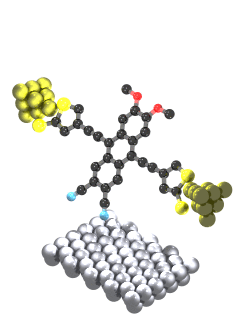Nanomotors: Tiny Engines Powering the Future of Nanotechnology
What are Nanomotors?
Nanomotors are tiny machines that can convert various forms of energy into motion at the nanoscale. These miniaturized engines, typically ranging in size from a few nanometers to several micrometers, are capable of performing complex tasks and have the potential to revolutionize fields such as medicine, environmental remediation, and materials science.

Types of Nanomotors
Nanomotors can be classified based on their propulsion mechanism, design, and the type of energy they harness:
Chemical Nanomotors
Chemical nanomotors convert chemical energy into motion. They typically rely on catalytic reactions that generate local gradients in concentration, pressure, or surface tension, which propel the nanomotor. Examples include bimetallic nanorods that move autonomously in hydrogen peroxide solutions and enzyme-powered nanomotors that operate in biological fluids.
Light-Driven Nanomotors
Light-driven nanomotors harness the energy of light to generate motion. They often incorporate photosensitive materials that undergo conformational changes or generate heat upon light exposure, leading to propulsion. Examples include azobenzene-based liquid crystal elastomer nanomotors and gold nanorod motors driven by near-infrared light.
Magnetic Nanomotors
Magnetic nanomotors are actuated by external magnetic fields. They typically consist of magnetic nanostructures, such as iron oxide nanoparticles or cobalt nanowires, which can be manipulated and guided using magnetic fields. Magnetic nanomotors offer precise control over their motion and can be used for targeted drug delivery and remote-controlled operations.
Ultrasound-Driven Nanomotors
Ultrasound-driven nanomotors utilize high-frequency sound waves to generate propulsion. They often incorporate gas-generating materials or asymmetric geometries that respond to ultrasound, leading to bubble propulsion or acoustic streaming. Ultrasound-driven nanomotors can penetrate deep into tissues and have potential applications in targeted drug delivery and imaging.
Propulsion Mechanisms
Nanomotors rely on various propulsion mechanisms to convert energy into motion. Some of the most common mechanisms include:
Self-Electrophoresis
Self-electrophoresis occurs when a nanomotor generates an electric field around itself due to asymmetric electrochemical reactions. The electric field interacts with the surrounding fluid, causing the nanomotor to move in the opposite direction. Bimetallic nanorods that catalyze the decomposition of hydrogen peroxide are a prime example of self-electrophoretic nanomotors.
Bubble Propulsion
Bubble propulsion relies on the generation and ejection of gas bubbles to propel the nanomotor. The bubbles can be produced by chemical reactions, such as the catalytic decomposition of hydrogen peroxide, or by the vaporization of a liquid using heat or ultrasound. As the bubbles grow and detach, they generate a recoil force that propels the nanomotor in the opposite direction.
Acoustic Streaming
Acoustic streaming is a phenomenon where high-frequency sound waves generate steady fluid flows. Nanomotors can be designed to harness these flows for propulsion. For example, asymmetric nanomotors with cavities or sharp edges can generate localized acoustic streaming when exposed to ultrasound, leading to directional motion.
Applications of Nanomotors
Nanomotors have diverse applications across various fields:
Biomedical Applications
Nanomotors have significant potential in biomedicine, particularly in drug delivery, diagnostics, and precision surgery. They can be designed to transport therapeutic payloads, such as drugs or genes, to specific targets in the body. Nanomotors can also be used as active sensors for the detection of biomarkers or pathogens. In precision surgery, nanomotors can assist in the removal of blood clots, plaque, or cancerous tissues.
Environmental Remediation
Nanomotors can be employed for environmental cleanup and water purification. They can be designed to actively seek out and degrade pollutants, such as organic contaminants or heavy metals. Catalytic nanomotors that decompose pollutants or magnetic nanomotors that can be guided to contaminated sites are promising candidates for environmental remediation.
Materials Science
Nanomotors can be used as active components in the development of smart materials and devices. They can be integrated into polymers, gels, or composites to create materials that respond to external stimuli or perform specific functions. For example, nanomotor-embedded materials can be used for self-healing, active cooling, or controlled release of substances.
Challenges and Future Perspectives
Despite the remarkable progress in nanomotor research, several challenges need to be addressed for their widespread application. Scaling up the production of nanomotors while maintaining their precision and reproducibility is a major hurdle. The development of biocompatible and biodegradable nanomotors for biomedical applications is also crucial to ensure their safety and minimize long-term side effects.
Future research in nanomotors will focus on improving their efficiency, controllability, and versatility. The integration of nanomotors with other functional nanomaterials, such as sensors, drug carriers, or catalysts, will enable the development of multifunctional nanorobots. The exploration of new energy sources, such as biochemical fuels or renewable energy, will expand the operating environments and sustainability of nanomotors.
Further Reading
Nanoscale, Man-Made Rotary Nanomotors
Chemical Reviews, Magnetically Driven Micro and Nanorobots
Chemical Society Reviews, Light-driven micro/nanomotors: from fundamentals to applications
